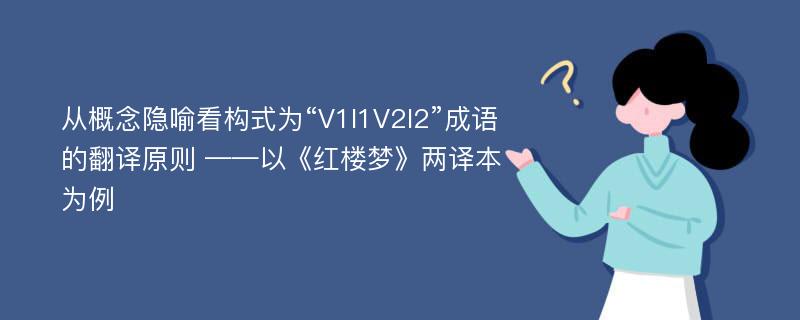
论文摘要
成语是汉语语言中的精华。它们是汉语特有的语言形式,具有与其他语言形式不同的特点。成语意象丰富,语义完整,结构精简固定。这些成语独有的语言特点使成语成为翻译中的一大难点。目前,虽然传统的翻译理论和方法十分繁杂,但大多只是针对综合文体,并没有建立针对成语特点的翻译理论和原则,因此传统的翻译方法缺乏系统性和针对性。西方概念隐喻理论的发展和构式语法的日趋完善为成语翻译提供了新的理论视角。概念隐喻的“思维观”让我们从新的角度重新认识了成语及成语翻译的内在本质。在传统的成语研究中,大多数学者只关注了成语的意象方面,或者只关注了成语的结构方面,然而,成语的意象和结构是共同发挥作用的。构式语法提出的“形式—意义”配对的观点为我们寻找成语元结构特征提供了理论基础,同时也保证了成语意象与结构两个层面能够相互作用,从而进行语义整合,生成成语义。本研究从概念隐喻和构式语法的理论为基础,通过对《红楼梦》两个译本中构式为“V1I1V212”成语的对比分析,拟提出三条成语翻译原则,旨在解决目前成语翻译方法缺乏系统性和针对性的问题,以期提高成语翻译的整体水平。
论文目录
ABSTRACT摘要ACKNOWLEDGEMENTSCHAPTER ONE INTRODUCTION1.1 Background of the study1.2 Significance of the study1.3 Overall structure of the studyCHAPTER TWO LITERATURE REVIEW2.1 The definitions of Chinese idioms and idioms in English2.1.1 The definition of Chinese idioms (成语)2.1.2 The definition of idioms in English2.1.3 The research objective in the present study2.2 The origins of Chinese idioms and idioms in English2.3 The characteristics of Chinese idioms2.3.1 The basic characteristics of Chinese idioms2.3.2 The special characteristics of Chinese idioms2.4 An overview of the studies of Chinese idiom translation2.5 An overview of conceptual metaphor2.5.1 The studies of metaphor2.5.2 The application of conceptual metaphor in translation2.6 An overview of construction grammar2.6.1 A brief summary of the studies of "construction"2.6.2 The schools of construction grammar2.6.3 The background of the current studies of construction grammar in ChinaCHAPTER THREE THE ENLIGHTENMENTS TO CHINESE IDIOMTRANSLATION FROM CONCEPTUAL METAPHOR AND CONSTRUCTIONGRAMMAR3.1 A new perspective of the nature of Chinese idioms3.1.1 Metaphorical characteristic originated from conceptual metaphor3.1.2 Constructional characteristic originated from construction grammar3.2 A new perspective of the nature of Chinese idiom translation3.3 The enlightenments to the translation principles of Chinese idiomsCHAPTER FOUR A CASE STUDY4.1 A brief introduction to the data collection4.2 Data analysis4.2.1 Comparison of the translation methods of images in the two translated versions4.2.2 Comparison of the translation methods in terms of structure in the two translated versions4.2.3 The causes of different translation methodsCHAPTER FIVE THE PRINCIPLES OF CHINESE IDIOM TRANSLATION5.1 The necessity of the principles of Chinese idiom translation and its target5.2 The limitations of traditional translation methods and the difficulties of Chinese idiom translation5.3 Principles of Chinese idiom translation5.3.1 Maintaining the metaphorical characteristic of the images, and connecting the relevant-cultural connotations between Chinese and English images5.3.2 Keeping the successful transference of the features of prototypical structure of Chinese idioms5.3.3 The mutual complementation between image translation and structural translationCHAPTER SIX CONCLUSION6.1 Main findings6.2 Limitations of this study6.3 Suggestions for the translator and the future studyREFERENCES
相关论文文献
标签:概念隐喻论文; 构式语法论文; 成语论文; 翻译原则论文; 红楼梦论文;
从概念隐喻看构式为“V1I1V2I2”成语的翻译原则 ——以《红楼梦》两译本为例
下载Doc文档
